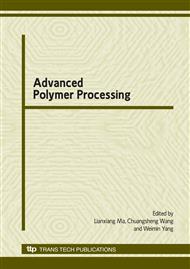p.323
p.329
p.333
p.339
p.345
p.351
p.357
p.363
p.369
Preparation and Properties Study on the Composites of Polypropylene and Polyphenylene Sulfide Filled by Modified Molybdenum Disulfide
Abstract:
The wet surface modification process were used in this work to get the well lipophilic molybdenum disulfide (MoS2) powders and the modified MoS2 were filled into the polyphenylene sulfide (PPS) and polypropylene (PP) powders with different proportions to make polymeric based composites through hot-press molding equipment. The Fourier transform infrared spectrometer (FT-IR) analysis showed that the modification agents of stearic acid (SA), orγ-Methacryloxypropyl trimethoxy silane(KH570 or A-174), could react with the adsorption hydroxyl(−OH) of the MoS2 powders and finally form chemical coatings, the SA could form a layer of physics wrap too. The powder X-ray diffraction (XRD) analysis reveled that the SA or KH570 could not change the laminated structure of MoS2. The wearability testing showed that the composites filled by modified MoS2 owned the better wearable performances than the filled not one. From minimum to maximum, the wear mass rates of SA/MoS2/PP/PPS, KH570/MoS2/PP/PPS, PP/PPS were 0.7216, 5.4187 and 7.3198 percent in turns. Scanning electronic microscope (SEM) analysis showed the surface modification could uniformize the modified MoS2 to disperse in the polymeric based composites, and also reflect the abrasion mechanism which the particles and the adhering wear modes could all make the mass loss of the testing samples and they coexisted and could transform each other, the former would produce higher loss rates than the later and their leader status would gradually change from the particles wear to the adhering wear during the course of wearing-resisting tests.
Info:
Periodical:
Pages:
345-350
Citation:
Online since:
December 2009
Authors:
Price:
Сopyright:
© 2010 Trans Tech Publications Ltd. All Rights Reserved
Share:
Citation:


